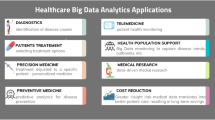Abstract
The paper by O’Loughlin et al (2005) 1 raises a number of issues in regard to the operation of the Hospital Inpatient Enquiry that require clarification and/or a response. In our view, there are many potential applications for these data that are not explored in this paper; our comments here, however, are of necessity limited to those issues raised by O’Loughlin et al (2005) in an attempt to ensure that a more balanced perspective on the operation of this system may be portrayed.
Similar content being viewed by others
References
O’Loughlin, R., S Allwright, J Barry, A Kelly, C TeljeurUsing HIPE data as a research and planning tool: limitations and opportunities, Irish J Med Sci, 2005; 174: p. 41–46.
Bramley M., and B. ReidTowards Best Practice in the Coding of Morbidity Data. A review of clinical coder training programs and data quality audit procedures within the Hospital In-Patient Enquiry Unit, ESRI. The University of Sydney 2004.
Coding Notes is a quarterly newsletter produced by the ESRI’s HIPE & NPRS Unit for coders and others involved in the HIPE system.
Canadian Institute for Health Information,Quality Assurance Processes Applied to the Discharge Abstract and Hospital Morbidity Databases. Canadian Institute for Health Information, Ottawa, 2002.
Canadian Institute for Health Information,Discharge Abstract Database Data Quality Re-abstraction Study, Combined Findings for Fiscal Years 1999/2000 and 2000/2001. Canadian Institute for Health Information, Ottawa, 2002.
National Centre for Classification in Health, The International Statistical Classification of Diseases and Related Health Problems, Tenth Revision, Australian Modification, (4th ed), Sydney, NCCH, 2004.
Murphy, D., M. M. Wiley, A. Clifton, D. McDonaghUpdating Clinical Coding in Ireland: Options and Opportunities, The Economic and Social Research Institute, Dublin, September 2004.
National Centre for Classification in Health,The Australian Coding Benchmark Audit (ACBA), Second Edition, National Centre for Classification in Health, University of Sydney, 2001.
Department of Health and Children Health Information: A National Strategy. Dublin: The Stationery Office, 2004.
The Economic and Social Research institute,Report on Perinatal Statistics for 2001, ESRI, Dublin, 2005.
Author information
Authors and Affiliations
Corresponding author
Rights and permissions
About this article
Cite this article
Wiley, M.M. Using HIPE data as a research and planning tool: limitations and opportunities: A response. Ir J Med Sci 174, 52–57 (2005). https://doi.org/10.1007/BF03169130
Issue Date:
DOI: https://doi.org/10.1007/BF03169130




